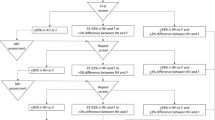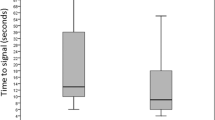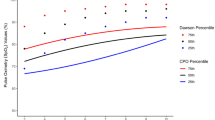Abstract
Background
Neonatal pulse oximetry screening (POS) algorithms for critical congenital heart disease (CCHD) have contributed towards decreasing neonatal mortality but cannot be applied at high altitudes. New POS algorithms at high altitudes are needed.
Methods
This observational, prospective study included newborns born at different altitudes from 0 to 4380 meters above the sea level in Peru. Healthy newborns underwent neonatal preductal and postductal oximetry, echocardiography and telephonic follow-up up to 12 months of age. Newborns with CCHD underwent preductal and postductal oximetry at the time of telemedicine evaluation while located at the high-altitude hospital where they were born, and their diagnoses were confirmed with echocardiography locally or after arriving to the referral center. Two new algorithms were designed using clinically accepted neonatal oximetry cutoffs or the 5th and 10th percentiles for preductal and postductal oximetry values.
Results
A total of 502 healthy newborns and 15 newborns with CCHD were enrolled. Echocardiography and telephonic follow-up were completed in 227 (45%) and 330 healthy newborns (65%), respectively. The algorithm based on clinically accepted cutoffs had a sensitivity of 92%, specificity of 73% and false positive rate of 27% The algorithm based on the 5th and 10th percentiles had a sensitivity of 80%, specificity of 88% and false positive rate of 12%.
Conclusions
Two algorithms that detect CCHD at different altitudes had adequate performance but high false positive rates.
This is a preview of subscription content, access via your institution
Access options
Subscribe to this journal
Receive 12 print issues and online access
$259.00 per year
only $21.58 per issue
Buy this article
- Purchase on Springer Link
- Instant access to full article PDF
Prices may be subject to local taxes which are calculated during checkout




Similar content being viewed by others
Data availability
The datasets generated during the current study are available from the corresponding author on reasonable request.
References
McKinnon B, Harper S, Kaufman JS, Bergevin Y. Socioeconomic inequality in neonatal mortality in countries of low and middle income: a multicountry analysis. Lancet Glob Health. 2014;2:e165–73.
Lehtonen L, Gimeno A, Parra-Llorca A, Vento M. Early neonatal death: a challenge worldwide. Semin Fetal Neonatal Med. 2017;22:153–60.
Collaborators GBDCHD. Global, regional, and national burden of congenital heart disease, 1990-2017: a systematic analysis for the Global Burden of Disease Study 2017. Lancet Child Adolesc Health. 2020;4:185–200.
Mahle WT, Newburger JW, Matherne GP, Smith FC, Hoke TR, Koppel R, et al. Role of pulse oximetry in examining newborns for congenital heart disease: a scientific statement from the American Heart Association and American Academy of Pediatrics. Circulation. 2009;120:447–58.
Chang RK, Gurvitz M, Rodriguez S. Missed diagnosis of critical congenital heart disease. Arch Pediatr Adolesc Med. 2008;162:969–74.
Martin GR, Ewer AK, Gaviglio A, Hom LA, Saarinen A, Sontag M, et al. Updated strategies for pulse oximetry screening for critical congenital heart disease. Pediatrics. 2020;146:e20191650.
Singh A, Rasiah SV, Ewer AK. The impact of routine predischarge pulse oximetry screening in a regional neonatal unit. Arch Dis Child Fetal Neonatal Ed. 2014;99:F297–302.
Abouk R, Grosse SD, Ailes EC, Oster ME. Association of US state implementation of newborn screening policies for critical congenital heart disease with early infant cardiac deaths. JAMA. 2017;318:2111–8.
Plana MN, Zamora J, Suresh G, Fernandez-Pineda L, Thangaratinam S, Ewer AK. Pulse oximetry screening for critical congenital heart defects. Cochrane Database Syst Rev. 2018;3:CD011912.
Paranka MS, Brown JM, White RD, Park MV, Kelleher AS, Clark RH. The impact of altitude on screening for critical congenital heart disease. J Perinatol. 2018;38:530–6.
Wright J, Kohn M, Niermeyer S, Rausch CM. Feasibility of critical congenital heart disease newborn screening at moderate altitude. Pediatrics. 2014;133:e561–569.
Meza K, Vasquez-Loarte T, Rodriguez-Alarcon J, San Roman O, Rojas-Camayo J, Mejia C, et al. Critical congenital heart disease detection in the ANDES: Challenges and opportunities. Int J Card Cong Heart Dis. 2022;10:100415.
Penaloza D, Arias-Stella J. The heart and pulmonary circulation at high altitudes: healthy highlanders and chronic mountain sickness. Circulation. 2007;115:1132–46.
Rojas-Camayo J, Mejia CR, Callacondo D, Dawson JA, Posso M, Galvan CA, et al. Reference values for oxygen saturation from sea level to the highest human habitation in the Andes in acclimatised persons. Thorax. 2018;73:776–8.
Brutsaert TD, Parra EJ, Shriver MD, Gamboa A, Rivera-Ch M, Leon-Velarde F. Ancestry explains the blunted ventilatory response to sustained hypoxia and lower exercise ventilation of Quechua altitude natives. Am J Physiol Regul Integr Comp Physiol. 2005;289:R225–34.
Winslow RM. The role of hemoglobin oxygen affinity in oxygen transport at high altitude. Respir Physiol Neurobiol. 2007;158:121–7.
Julian CG, Moore LG. Human genetic adaptation to high altitude: evidence from the Andes. Genes (Basel). 2019;10:150.
Hoffman JI. Is pulse oximetry useful for screening neonates for critical congenital heart disease at high altitudes? Pediatr Cardiol. 2016;37:812–7.
Penaloza D. Effects of high-altitude exposure on the pulmonary circulation. Rev Esp Cardiol (Engl Ed). 2012;65:1075–8.
Salas AA. Pulse oximetry values in healthy term newborns at high altitude. Ann Trop Paediatr. 2008;28:275–8.
Ministerio de Salud del estado plurinacional de Bolivia. Detección de Cardiopatías Congénitas por Oximetría de pulso. Serie: Documentos Tecnicos Normativos. La Paz, Bolivia; 2019. https://www.bivica.org/files/5588_Folleto%20Detecci%C3%B3n%20de%20cardiopat%C3%ADas%20cong%C3%A9nitas%20y%20oximetr%C3%ADa%20de%20pulso.pdf
Thangaratinam S, Brown K, Zamora J, Khan KS, Ewer AK. Pulse oximetry screening for critical congenital heart defects in asymptomatic newborn babies: a systematic review and meta-analysis. Lancet. 2012;379:2459–64.
Ravert P, Detwiler TL, Dickinson JK. Mean oxygen saturation in well neonates at altitudes between 4498 and 8150 feet. Adv Neonatal Care. 2011;11:412–7.
Beall CM, Almasy LA, Blangero J, Williams-Blangero S, Brittenham GM, Strohl KP, et al. Percent of oxygen saturation of arterial hemoglobin among Bolivian Aymara at 3,900-4,000 m. Am J Phys Anthropol. 1999;108:41–51.
Sneeringer MR, Vadlaputi P, Lakshminrusimha S, Siefkes H. Lower pass threshold (>/=93%) for critical congenital heart disease screening at high altitude prevents repeat screening and reduces false positives. J Perinatol. 2022;42:1176–82.
Funding
This study was supported by the University of California, Los Angeles Global Health Seed Grant 2021.
Author information
Authors and Affiliations
Contributions
Katia Bravo-Jaimes conceptualized and designed the study, drafted the initial manuscript, coordinated and supervised data collection, and critically reviewed and revised the manuscript. Jose Rojas-Camayo, Leigh Reardon and Jeannette Lin conceptualized and designed the study, and critically reviewed and revised the manuscript. Tania Vasquez-Loarte, Christian R. Mejia and Henry Zapata-Galarza designed the data collection instruments and critically reviewed and revised the manuscript. Zhuo Li carried out the analyses and critically reviewed and revised the manuscript. Kiran Mitha and Juan Alejos critically reviewed and revised the manuscript. Monica Medina, Marilia Berrocal, Jeanette Orozco, Daniel Lozano, Maryuri Santivañez, Carlos Sangay, William Rosales, Leddy Mamani, Nelly Macedo, Joel Coronado, Gian Huaman, and Rafael Marquez coordinated and supervised data collection, and critically reviewed and revised the manuscript for important intellectual content. All authors approved the final manuscript as submitted and agree to be accountable for all aspects of the work.
Corresponding author
Ethics declarations
Competing interests
The authors declare no competing interests.
Additional information
Publisher’s note Springer Nature remains neutral with regard to jurisdictional claims in published maps and institutional affiliations.
Rights and permissions
Springer Nature or its licensor (e.g. a society or other partner) holds exclusive rights to this article under a publishing agreement with the author(s) or other rightsholder(s); author self-archiving of the accepted manuscript version of this article is solely governed by the terms of such publishing agreement and applicable law.
About this article
Cite this article
Bravo-Jaimes, K., Vasquez-Loarte, T., Rojas-Camayo, J. et al. A new algorithm DEtectS critical Congenital Heart Disease at different altitudes: ANDES-CHD study. J Perinatol 44, 373–378 (2024). https://doi.org/10.1038/s41372-024-01888-5
Received:
Revised:
Accepted:
Published:
Issue Date:
DOI: https://doi.org/10.1038/s41372-024-01888-5



